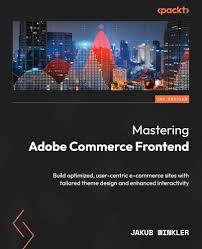Adobe Commerce Front-End Design: A Comprehensive Guide
Introduction
Adobe Commerce, formerly Magento, is a popular e-commerce platform that empowers businesses to create and manage online stores. The front-end design of an Adobe Commerce store plays a crucial role in attracting and engaging customers. This white paper provides a comprehensive guide to Adobe Commerce front-end design, covering key considerations, best practices, and essential tools.
Understanding Front-End Design
The front-end design of an Adobe Commerce store refers to the visual elements that customers interact with, including the layout, colors, typography, images, and overall user experience. A well-designed front-end can significantly impact customer satisfaction, conversion rates, and brand perception.
Key Considerations for Adobe Commerce Front-End Design
- User Experience (UX): Prioritize a seamless and intuitive user experience. Ensure that the navigation is clear, the checkout process is straightforward, and the content is easy to find.
- Mobile Optimization: With the increasing number of mobile users, it's essential to design your Adobe Commerce store for optimal performance on various devices and screen sizes.
- Accessibility: Make your store accessible to users with disabilities by adhering to accessibility guidelines like WCAG.
- Performance: Optimize your store for speed to improve user experience and search engine rankings. Consider factors like image optimization, caching, and code minification.
- Branding: Reflect your brand identity through consistent design elements, colors, and typography.
- SEO: Optimize your front-end design for search engines to improve visibility and attract organic traffic. Use relevant keywords in headings, meta descriptions, and image alt text.
Best Practices for Adobe Commerce Front-End Design
- Use a Responsive Theme: Choose a theme that is designed to adapt to different screen sizes, ensuring a consistent experience across devices.
- Leverage Adobe Commerce's Page Builder: Utilize the Page Builder to create custom page layouts and designs without extensive coding knowledge.
- Optimize Images: Compress images to reduce file size and improve page load times. Use appropriate image formats (e.g., JPEG, PNG) based on content.
- Prioritize Clear Navigation: Create a well-organized menu structure that is easy for customers to navigate.
- Use High-Quality Visuals: Invest in high-quality images and videos to enhance the visual appeal of your store.
- Test Regularly: Continuously test your store on different devices and browsers to ensure optimal performance and identify any issues.
Essential Tools for Adobe Commerce Front-End Design
- Adobe Commerce Theme Development: Use Adobe Commerce's theme development tools to customize the look and feel of your store.
- CSS Preprocessors: Consider using CSS preprocessors like Sass or Less for efficient and maintainable stylesheets.
- Version Control: Implement a version control system (e.g., Git) to track changes and collaborate effectively.
- Browser Developer Tools: Utilize browser developer tools to inspect and debug your front-end code.
- Performance Optimization Tools: Use tools like Google PageSpeed Insights to identify performance bottlenecks and optimize your store.
Conclusion
A well-designed front-end is essential for the success of your Adobe Commerce store. By following the best practices and utilizing the right tools, you can create a visually appealing and user-friendly online shopping experience that drives conversions and customer satisfaction.Contact keencomputer.com for details.
References
- Adobe Commerce Documentation: https://magento.stackexchange.com/
- Third-Party Resources: https://www.w3schools.com/howto/howto_website.asp
- Accessibility Guidelines:
